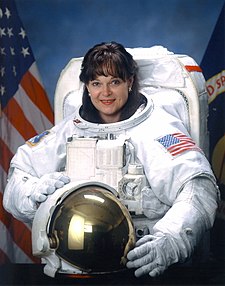Tamara Elisabeth Jerniganová
| Tamara Elisabeth Jerniganová | |
|---|---|
 Tamara Elisabeth Jerniganová | |
| Astronaut NASA | |
| Státní příslušnost | |
| Datum narození | 7. května 1959 (64 let) |
| Místo narození | Chattanooga, Tennessee |
| Předchozí zaměstnání | vědkyně |
| Čas ve vesmíru | 63 dní, 01 hodin a 24 minut |
| Kosmonaut od | 1985 |
| Mise | STS-40, STS-52, STS-67, STS-80, STS-96 |
| Znaky misí | |
| Kosmonaut do | 2001 |
| Pozdější zaměstnání | důchodkyně |
| Některá data mohou pocházet z datové položky. | |
Tamara Elisabeth Jerniganová (* 7. května 1959 Chattanooga) je americká vědkyně a astronautka. Ve vesmíru byla celkem pětkrát.
Život
Studium a zaměstnání
V roce 1977 ukončila střední školu Santa Fe High School v Kalifornii, poté studovala na Stanfordově univerzitě. Po ukončení studia na Stanfordově univerzitě v roce 1983 pokračovala ve studiu na Kalifornské univerzitě v Berkeley a na Rice University. V roce 1988 studia ukončila titulem Ph.D. fyziky a astronomie. V roce 1985 absolvovala výcvik astronauta u Národního úřadu pro letectví a vesmír, od roku 1986 pak byla zařazena mezi astronauty. V této pozici zůstala roku 2001. Poté pracovala ve společnosti Lawrence Livermore National Laboratory.
Jejím manželem je o rok starší americký astronaut Peter Wisoff. Její přezdívka je Tammy.
Lety do vesmíru
Na oběžnou dráhu se v raketoplánech dostala pětkrát, ve vesmíru strávila 63 dní, 1 hodinu a 24 minut. Absolvovala jeden výstup do volného vesmíru, při instalaci zařízení u ISS strávila vně stanice hodinu a 55 minut. Byla 251. člověkem ve vesmíru, 16. ženou.
- STS-40 Columbia (5. června 1991 – 14. června 1991), letová specialistka
- STS-52 Columbia (22. října 1992 – 1. listopadu 1992), letová specialistka
- STS-67 Endeavour (2. března 1995 – 18. března 1995), velitelka užitečného zařízení, letová specialistka
- STS-80 Columbia, (19. listopadu 1996 – 7. prosince 1996), letová specialistka
- STS-96, Discovery (27. května 1999 – 6. června 1999), letová specialistka
Odkazy
Externí odkazy
 Obrázky, zvuky či videa k tématu Tamara Elisabeth Jerniganová na Wikimedia Commons
Obrázky, zvuky či videa k tématu Tamara Elisabeth Jerniganová na Wikimedia Commons - Tamara Elizabeth Jernigan. Space [online]. Dostupné online. (anglicky)
- MEK - Jerniganová, T.E.. Mek-Kosmo [online]. [cit. 2021-02-22]. Dostupné online. (anglicky)
Média použitá na této stránce
Astronaut Tamara E. Jernigan in an Extravehicular Mobility Unit (EMU) spacesuit
This mission patch for mission STS-80 depicts the Space Shuttle Columbia and the two research satellites its crew deployed into the blue field of space. The uppermost satellite is the Orbiting Retrievable Far and Extreme Ultraviolet Spectrograph-Shuttle Pallet Satellite (ORFEUS-SPAS), a telescope aimed at unraveling the life cycles of stars and understanding the gases that drift between them. The lower satellite is the Wake Shield Facility (WSF), flying for the third time. It will use the vacuum of space to create advanced semiconductors for the nation's electronics industry. ORFEUS and WSF are joined by the symbol of the Astronaut Corps, representing the human contribution to scientific progress in space. The two bright blue stars represent the mission's Extravehicular Activities (EVA), final rehearsals for techniques and tools to be used in assembly of the International Space Station (ISS). Surrounding Columbia is a constellation of 16 stars, one for each day of the mission, representing the stellar talents of the ground and flight teams that share the goal of expanding knowledge through a permanent human presence in space.
STS-52 Columbia, Orbiter Vehicle (OV) 102, crew insignia (logo), the Official insignia of the NASA STS-52 mission, features a large gold star to symbolize the crew's mission on the frontiers of space. A gold star is often used to symbolize the frontier period of the American West. The red star in the shape of the Greek letter lambda represents both the laser measurements to be taken from the Laser Geodynamic Satellite (LAGEOS II) and the Lambda Point Experiment, which is part of the United States Microgravity Payload (USMP-1). The LAGEOS II is a joint Italian \ United States (U.S.) satellite project intended to further our understanding of global plate tectonics. The USMP-1 is a microgravity facility which has French and U.S. experiments designed to test the theory of cooperative phase transitions and to study the solid\liquid interface of a metallic alloy in the low gravity environment. The remote manipulator system (RMS) arm and maple leaf are emblematic of the Canadian payload specialist Steven MacLean.
STS-40 Mission Insignia
Designed by the crew members, this is the mission insignia for the STS-96 space flight, the second Space Shuttle mission dedicated to the assembly of the International Space Station (ISS). The crew patch highlights the major themes of the Station Program: Earth-directed research, the advancement of human space exploration, and international cooperation. The Space Shuttle Discovery is depicted shortly after reaching orbit as the crew prepares to carry out the first docking with the new Station. At this early stage in its construction, ISS consists of two modules: Zarya and Unity, shown orbiting Earth. The triangular shape of the patch represents building on the knowledge and experience of earlier missions, while the three vertical bars of the astronaut emblem point toward future human endeavors in space. The five-pointed star that tops the astronaut emblem in this depiction is symbolic of the five space agencies participating in the development of ISS: NASA, the Russian Space Agency, the European Space Agency, the National Space Development Agency of Japan, and the Canadian Space Agency. The blend of red, white, and blue is a tribute to the nationalities of the crew members who are from the United States, Canada, and Russia.
STS-67 Mission Insignia






